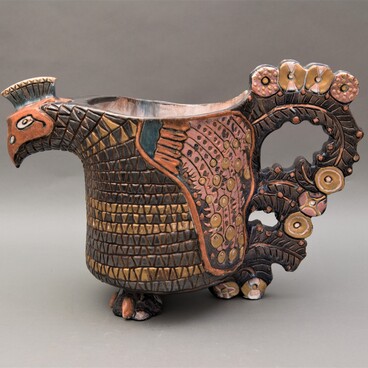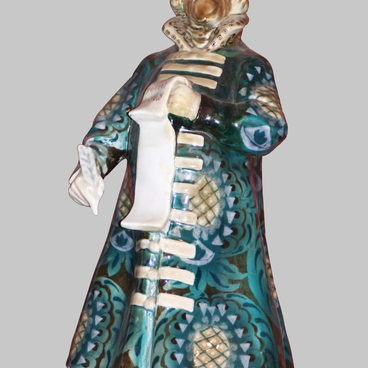Flask in the Russian style was made in the ceramic workshop of the Imperial Stroganov Central School of Industrial Art at the beginning of the 20th century. The Stroganov School is one of the oldest art and industrial institutions in Europe. It was opened in 1825 under the name ‘School of Drawing in Relation to Arts and Crafts’.
The school was founded by the participant of the Patriotic War of 1812, Count Sergei Stroganov at his own expense. Education and meals for students were free, children of commoners and serfs were admitted to the school, and the criterion for admission to study was not the privileged position of parents, but the applicant’s talent, his ability to draw, artistic creativity. In 1843, Stroganov transferred the school to the state, and in 1860 it became part of a new educational institution of a higher level — the Stroganov School of Technical Drawing. The main task that the educational institution faced was training draftsmen for the manufacturing industry, factory production and crafts.
“The goal of the Stroganov School of Technical Drawing is to educate draftsmen and ornamentalists for manufacturing and crafts and to contribute to the development of artistic abilities in industrial classes in general” — this was stated in the Regulations on the school. Production workshops were established at the school, one of the first was a pottery workshop.
At the 1900 Paris Exhibition, ceramics created at the Stroganov School were awarded a silver medal. In the same year, the school received the status of the Imperial educational institution.
In their works, the students of the Stroganov School often turned to the reproduction and creative rethinking of old forms of decorative and applied art. One of the examples of such reproduction is the flask in the Russian style of the 17th century.
Such flasks were ancient Russian vessels for wine or oil with a long narrow neck. Traditionally, such vessels were made of clay, silver or gold. The choice of material was determined by the status and capabilities of the customer. The flask presented in the exhibition is covered with glaze and decorated with ornaments: it seems that the vessel is not made of clay but is made of precious metals.
The school was founded by the participant of the Patriotic War of 1812, Count Sergei Stroganov at his own expense. Education and meals for students were free, children of commoners and serfs were admitted to the school, and the criterion for admission to study was not the privileged position of parents, but the applicant’s talent, his ability to draw, artistic creativity. In 1843, Stroganov transferred the school to the state, and in 1860 it became part of a new educational institution of a higher level — the Stroganov School of Technical Drawing. The main task that the educational institution faced was training draftsmen for the manufacturing industry, factory production and crafts.
“The goal of the Stroganov School of Technical Drawing is to educate draftsmen and ornamentalists for manufacturing and crafts and to contribute to the development of artistic abilities in industrial classes in general” — this was stated in the Regulations on the school. Production workshops were established at the school, one of the first was a pottery workshop.
At the 1900 Paris Exhibition, ceramics created at the Stroganov School were awarded a silver medal. In the same year, the school received the status of the Imperial educational institution.
In their works, the students of the Stroganov School often turned to the reproduction and creative rethinking of old forms of decorative and applied art. One of the examples of such reproduction is the flask in the Russian style of the 17th century.
Such flasks were ancient Russian vessels for wine or oil with a long narrow neck. Traditionally, such vessels were made of clay, silver or gold. The choice of material was determined by the status and capabilities of the customer. The flask presented in the exhibition is covered with glaze and decorated with ornaments: it seems that the vessel is not made of clay but is made of precious metals.

